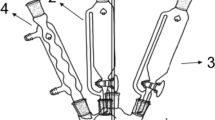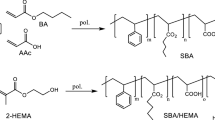Abstract
Core-shell latexes were synthesized by sequential emulsion polymerization of methyl methacrylate (MMA), styrene (St), and ethyl acrylate (EA) in the presence of anionic surfactant, and the characteristics of these latexes were evaluated. The core latex had to be synthesized carefully to avoid the formation of secondary particles. The sequential polymerization method adopted for this synthesis took advantage of stabilizing particles grown during shell polymerization. In core-shell latex polymerization, to suppress the generation of new particles and to minimize the gelation during the shell polymerization, the amount of surfactant (Sodium dodecyl benzene sulfonate: SDBS) should be reduced to the minimum, 0.01 wt% and 0.02 wt% of SDBS to amount of monomer, respectively, when the Polymethyl methacrylate (PMMA) and Polystyrene (PSt) core latexes are prepared. In addition, the monomer pre-emulsion method is better than monomer-add method. The core-shell structure for composite latex synthesized was demonstrated by Particle Size Analysis (PSA), Differential Scanning Calorimeter (DSC), Transmission Electron Microscope (TEM), formability of film, and hydrolysis under NaOH solution.
Similar content being viewed by others
References
Blankenship, R. and Kowalski, A., “Production of Core-sheath Polymer Particles Containing Voids, Resulting Product and Use”, U.S. Patent,4, 594, 363 (1986).
Devon, Michael J., “Effects of Core-shell Latex Morphology on Film Forming Behavior”,J. Appl. Polym. Sci.,39,2119 (1990).
Fabre, P., Drujon, X., Meunier, G. and Leibler, L., “Films from Soft-Core/Hard-Shell Hydrophobie Latexes: Structure and Thermomechanical Properties”,J. Polymer Science,38, 2989 (2000).
Grancio, M. R. and Williams, D. J., “Molecular Weight Development in Constant-Rate Styrene Emulsion Polymerization”,J. Polym. Sci.,8, 2733 (1970).
Grancio, M. R. and Williams, D. I., “The Morphology of the Monomer-polymer Particle in Styrene Emulsion Polymerization”,J. Polym. Sci.,8, 2617 (1970).
Keusch, P. and Williams, D. J., “Equilibrium Encapsulation of Polystyrene Latex Particles”,J. Polym. Sci.,11,143 (1973).
Kim, S. S., Chun, B. H., Park, C. J. and Yoon, W K., “Pyrolysis Characteristics of Polystyrene on Stirred Batch Reactor”,HWAHAK KONGHAK,38, 732 (2000).
Kim, Y. S., Hwang, G. C, Bae, S. Y. and Yi, S. C., “Pyrolysis of Polystyrene in a Batch-Type Stirred Vessel”,Korean J. Chem. Eng.,16, 161 (1999).
Lee, C.-F., “Synthesis and Properties of Polymer Latex with Carboxylic Acid Functional Groups for Immunological Studies”,J. Polymer,41, 8565 (2000).
Lee, C.-F., “The Properties of Core-shell Composite Particles”,Polymer,41, 1337(2000).
Lee, D. I. and Ishikawa, T., “The Formation of ”,Inverted”, Core-Shell latex”,J. Polym. Sci Polym. Chem. Ed.,21, 147 (1983).
Morgan, L. W., Johnson, S. C. and Son, “Multifeed Emulsion Polymer: The Effects of Monomer Feed Sequence and the Use of Seed Emulsion Polymers”,J. Appl. Polym. Sci.,27, 2033 (1982).
Okubo, M. and Lzumi, J., “Synthesis of Micron-sized Monodispersed, Core-shell Composite Polymer”,Colloids and Surfaces A: Physiochemical and Engineering Aspects,153,297 (1999).
Okubo, M., Katsuta, Y. and Matsumoto, T., “Studies on Suspension and Emulsion. LI. Peculiar Morphology of Composite Polymer Particles Produced by Seeded Emulsion Polymerization”,J. Polym. Sci. Polym. Letter Ed.,20,45 (1982).
Okubo, M., Katsuta, Y., Inoue, K., Nakamae, K. and Matsumoto, T., “Dynamic Viscoelastic Behavior of Composite Polymer Emulsion Film”,16(7), 278 (1980).
Park, J. Y., Kwon, M. H., Lee, Y S. and Park, O. O., “Effects of Nucleating Agent on Nonisothermal Crystallization of Syndiotactic Polystyrene”,Korean J. Chem. Eng.,17, 262 (2000).
Park, S. J., “A Study on the Effect of Surfactants in Acrylic Emulsion Polymerization”,J. Korean Ind. Eng. Chem.,10(4), 523 (1999).
Paxton, T R., “Adsorption of Emulsifier on Polystyrene and Poly(Methyl Methacrylate) Latex Particle”,J. Colloid Interface. Sei,31(1), 19 (1969).
Sarac, A. S., “Redox Polymerization”,Prog. Polym. Sci.,24,1149 (1999).
Song, H. S. and Hyun, J. C., “An Optimization Study on the Pyrolysis of Polystyrene in a Batch Reactor”,Korean J. Chem. Eng.,16, 316 (1999).
Williams, D. J. and Keusch, P., “Latex Particle Morphology during Polymerization and at Saturation Equilibrium”,J. Polym. Sci. Chem. Ed.,12,2123 (1974).
Author information
Authors and Affiliations
Corresponding author
Rights and permissions
About this article
Cite this article
Lee, SR., Seul, SD. A study on the synthesis of acrylic composite particles and investigation of their characterization. Korean J. Chem. Eng. 19, 318–323 (2002). https://doi.org/10.1007/BF02698422
Received:
Accepted:
Issue Date:
DOI: https://doi.org/10.1007/BF02698422




